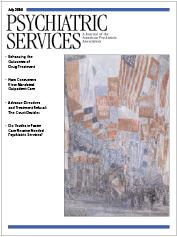Relationship Between Drug Treatment Services, Retention, and Outcomes
Abstract
OBJECTIVE: This longitudinal study conducted path analyses to examine the relationships between treatment processes and outcomes among patients in community-based drug treatment programs. METHODS: A total of 1,939 patients from 36 outpatient drug-free and residential treatment programs in 13 California counties were assessed at intake, discharge, three months after admission, and nine months after admission. Path analyses were conducted to relate the quantity and quality of services that were received in the first three months of treatment to treatment retention and outcomes at the nine-month follow-up. Patients were determined to have a favorable outcome if for at least 30 days before the follow-up assessment they did not use drugs, were not involved in criminal activity, and lived in the community. The path analyses controlled for patients' baseline characteristics. RESULTS: Greater service intensity and satisfaction were positively related to either treatment completion or longer treatment retention, which in turn was related to favorable treatment outcomes. Patients with greater problem severity received more services and were more likely to be satisfied with treatment. These patterns were similar for patients regardless of whether they were treated in outpatient drug-free programs or residential programs. CONCLUSIONS: The positive association between process measures—that is, greater levels of service intensity, satisfaction, and either treatment completion or retention—and treatment outcome strongly suggests that improvements in these key elements of the treatment process will improve treatment outcomes.



